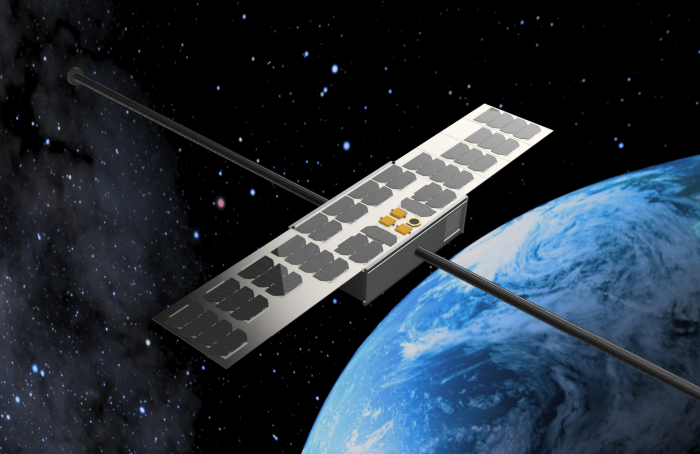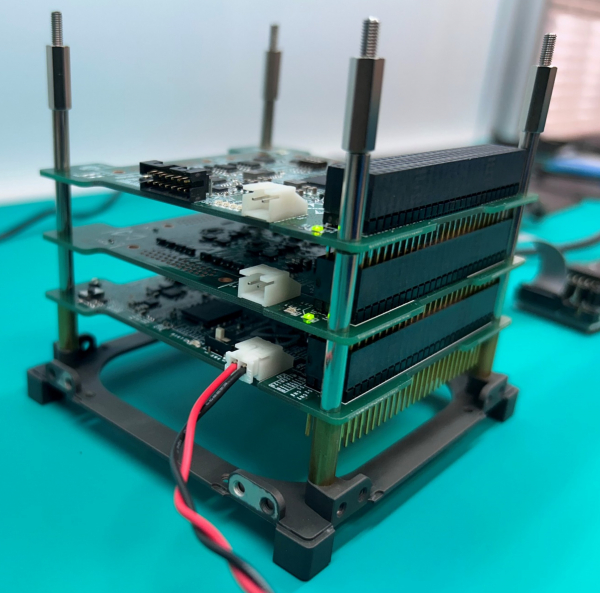The Japan Aerospace Exploration Agency (JAXA) has selected the "Investigation of ducting Magnetospheric Plasma wave ACTivity" (IMPACT) project as part of the JAXA-Small Satellite Rush Program (JAXA-SMASH), which supports collaborations between government, industry, and academia to realise microsatellite missions and diversify transportation services. After completing the feasibility study, the IMPACT Project has now progressed to the satellite development phase. We delve into the details of this new satellite mission below.
Selection by JAXA-SMASH
The IMPACT Project is a nano-satellite design to investigate how plasma waves in space travel through passageways ("ducts",※1) of low or high density towards the Earth. Plasma waves play an important role in space weather around the Earth, and understanding their propagation is essential to improve the safety of exploration around our planet and into deep space.
The plan for the IMPACT Project nano-satellite was selected for the feasibility study phase of the JAXA-SMASH Microsatellite Mission Call #2 in December 2023, and the official decision to progress to the satellite development phase followed the success of the phase-up evaluations. During the satellite development phase, the design, development and testing of the satellite will be performed with the goal of completing development in March 2027. To develop the IMPACT Project nano-satellite, Professor Shinohara Iku, Associate Professor Asamura Kazushi, and Assistant Professor Mitani Takefumi at the JAXA Institute of Space and Astronautical Science (ISAS), Department of Solar System Sciences are establishing a collaborative research team with members that include Associate Professor Matsuda Shoya, Advanced Research Center for Space Science and Technology, Institute of Science and Engineering, Kanazawa University, and researchers from Tohoku University, The University of Tokyo, Kyoto University, Nagoya University, Kyushu Institute of Technology, and the National Institute of Information and Communications Technology. The design of the satellite will combine the strengths of each institution, and the final production will be completed principally by the staff and students at Kanazawa University. Each institute will also be involved in performing the scientific observations and the results. By combining the scientific analysis specialisations of each institute (such as theoretical calculations, simulations, and modelling) with the observational data collected by IMPACT, we aim to maximise the scientific achievements from the mission.
The IMPACT Project science
Changes to the space plasma environment, which are important to accelerate the safe use of outer space, are known as 'space weather'. As space utilization continues to increase, it is likely that space weather will become as familiar as the weather forecasts on Earth. An important factor in determining space weather are the natural electromagnetic waves that occur in space, known as plasma waves. Plasma waves are a phenomenon in which oscillating electric and magnetic fields propagate through space and exchange energy with charged particles (plasma), causing these particles to scatter and accelerate. Because these are "waves", plasma waves can originate far away in space, sometimes travelling distances of tens of thousands of kilometers before reaching the surface of Earth. The path that they travel is called a "duct", and acts like a tunnel connecting space and the Earth.
The IMPACT Project is a solar-terrestrial science mission that makes observations using a W6U-sized (approximately 10cm x 22cm x 36cm) CubeSat. The IMPACT Project nano-satellite will orbit the Earth at an altitude of 500-600 km and capture plasma waves transmitted from space to Earth along ducts through this area to investigate when, why, and what kinds of plasma waves reach Earth. By directly measuring the plasma, The IMPACT Project nano-satellite will obtain evidence of how plasma waves along a duct change the space plasma environment, and clarify how such distant space phenomena affect low-altitude regions close to the Earth.
As the duct is a path that transmits plasma waves from space to Earth, in the future such passageways could be used to deliver electromagnetic waves from Earth to space. Utilizing ducts to monitoring and control of the space environment could contribute to the safety of artificial satellites and crewed space exploration. Additionally, the IMPACT Project will pioneer space weather measurements using nano-satellites, aiming to understand space weather patterns in three-dimensions, which is particularly difficult to achieve with conventional large satellites.
Artist image of the IMPACT Project nano-satellite in-orbit around the Earth. © Kanazawa University.
IMPACT Project outlook
The IMPACT Project nano-satellite will carry a ultra-small AI onboard processor, "AI-OBC", which is being developed by Kanazawa University. AI-OBC is designed to help with labor-saving for satellite operations and the effective use of limited communication resources by employing deep learning models to make autonomous decisions and identify and classify scientific phenomena on scientific satellites. AI-OBC is equipped with a microcomputer with a "Dynamically Reconfigurable Processor (DRP)" architecture (※2), which enables high-speed processing of matrix operations and convolution processing, achieving AI inference speeds that are approximately 100 times faster for similar power consumption as conventional satellite-mounted CPUs. Applications include a significant reduction in communication resources and a dramatic improvement in science output by automatically selecting and extracting important data and features from vast amounts of scientific observation data, as well as anomaly detection based on housekeeping data from the satellite bus system. By implementing this functionality inexpensively using a COTS (Commercial Off-the-Shelf, ※3) microcomputer, and installing the real-time operating system, T-Kernel 2.0 Aerospace (※4), used for satellites, real-time control of the satellite bus system combined with AI models and highly functional scientific data processing systems can be achieved. The deep learning model installed on AI-OBC has an extremely flexible design, allowing it to be used for a variety of purposes, not only as the main computer in a nano-satellite, but also as a processor for subcomponents and mission equipment for small to large satellites, or for tasks such as controlling observation instruments at lunar observation bases or navigation control of autonomous vehicles. The plan is to accumulate operational experience in orbit through the satellite development and operation of the IMPACT Project, and in the future, deploy AI-OBC as a versatile scientific device for a wide range of applications, with the aim of installing the AI processor in extreme environments such as on the lunar surface and polar regions.
AI-OBC (breadboard model) © Kanazawa University
The role of ISAS in the IMPACT Project
The concept of the IMPACT Project was inspired by the scientific achievements of the magnetosphere observation satellite, AKEBONO, and the Exploration of energization and Radiation in Geospace, ARASE (ERG). These JAXA satellites, equipped with extremely high-performance instruments for measuring plasma wave and particle physics, have made it possible to precisely unravel microscopic physical processes, such as in-situ plasma behavior and wave-particle interactions. Approximately nine years have passed since the launch of ARASE, during which the sophistication and miniaturization of observational instruments has matured. This progression has made it possible to realize high-precision space weather measurements even using CubeSats like those of the IMPACT Project, and so allow innovative missions to be proposed that take advantage of this flexibility. One of the roles of the Institute of Space and Astronautical Science in the IMPACT Project is to demonstrate the potential of science using nano-satellites, starting with the IMPACT Project, and to lead this to the realization of ultra-multipoint observations and satellite constellations in the future.
※1 This refers to a tube-shaped region where the plasma density is locally either high or low. Plasma waves are reflected and refracted at the inner boundary of the duct, allowing energy to propagate long distances without being dissipated.
※2 Hardware developed by Renesas Electronics Corporation that executes applications while dynamically switching connections between computing units. DRP is characterized by the combination of high processing capability of the hardware logic, and the high flexibility and functional expandability similar to a CPU.
※3 This refers to the utilization of commercial parts not exclusively designed for the space industry, enabling inexpensive and rapid development of onboard equipment.
※4 A highly reliable real-time operating system developed for aerospace applications. It provides high-performance yet low-overhead memory protection and time management features, and is used to ensure stable operation of spacecraft.


